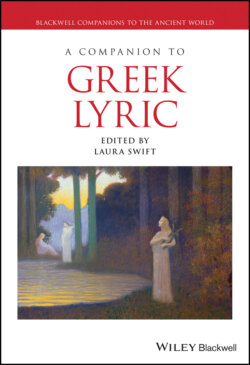Читать книгу A Companion to Greek Lyric - Группа авторов - Страница 37
VII Ibycus’ Epic Lesson: Flattering Polycrates
ОглавлениеSo far we have seen a variety of lengths, details, and approaches to heroic myth, but the longest extant example of a mythical narrative before Stesichorus (see below) comes in the so-called “Polycrates Ode” by the mid-sixth-century BC poet Ibycus of Rhegium (in Italy) (fr. S 151 PMGF).36 This composition was written to praise Polycrates, tyrant of Samos, and did so by associating him with the great heroes of the Trojan War. Here the assertion of lyric dialect and language combines a clear appropriation and recreation of epic norms: for instance, the expression Δαρδανίδα Πριάμοιο (“of Dardanus’ son Priam” 1) combines the standard epic form of Priam’s name with a patronymic showing a non-epic, Doric inflection (Δαρδανίδα ~ Δαρδανιδάο).37 Moreover, lines 20–22 (τῶν] μὲν κρείων Ἀγαμέ̣[μνων / ἆ̣ρ̣χε Πλεισθ[ενί]δας βασιλ̣[εὺ]ς̣ ἀγὸς ἀνδρῶν / Ἀτρέος ἐσ[θλὸς π]άις ἔκγ̣[ο]νος “their leader was powerful Agamemnon/the Pleisthenid, king, leader of men/noble trueborn son of Atreus”) obviously allude to an entry in the Iliad’s Catalogue of Ships with the typical epic formula κρείων Ἀγαμέμνων “powerful Agamemnon” (41x Il., 1x Od., 1x Little Iliad), though the entry is also “lyricized” by the non-epic vocalism for the patronymic Πλεισθ[ενί]δας (~ Πλεισθενίδης). Incidentally, the genealogy given here combines the Homeric tradition that Agamemnon was the son of Atreus with the Hesiodic conception that he was Pleisthenes’ son (Hes. frr. 194–195 M–W): Ibycus sides with Homer,38 but includes Hesiod’s tale. Finally, the expression κλέος ἄφθιτον “glory imperishable” reiterates the creation of a mixed lyric/epic tradition, since this epic phrase (Il. 9.413, Hes. fr. 70.5 M–W) had already been appropriated by Sappho (fr. 44.4 [below]).39
This reproduction and reworking of epic language is obviously aided by the dactylic rhythm of the triad (i.e., strophe/antistrophe/epode) which, as with the stanzaic constructions examined earlier, affords the poet semantic opportunities of a sort denied to epic: note, e.g., the considerable syntactical continuity within the units of each triad (e.g., 4–5, 13–14, etc.), but the strong pause between them (9–10, 22–23, etc.). Moreover, the enclosed two triads have the same structure—refusal to sing about the Trojan War in the usual way (10–12 f., 23–6 f.), then the Greek ships coming to Troy (14–19, 27–31), followed by entries which allude to the Catalogue of Ships (20–22, 32–35)—which helps to underline the self-consciously novel nature of the final comparison (see below), but which also focuses on Ibycus’ advertisement of his decision not to give a standard treatment of the material, most notably perhaps in his refusal to invoke the Muses, that standard source of epic inspiration and authority, rather than merely noting where their narrative preference would otherwise take him (23–24).
Indeed, the poem self-consciously manipulates, recreates, and refuses epic norms throughout. Ibycus reframes the war and its epic treatment through the decidedly un-epic erotic theme with which the text closes, as Polycrates is praised by being set among a series of impressive male figures specifically for his looks (“for these men there will always be a share of beauty;/so you too, Polycrates, will have glory imperishable/as can be in song and my fame” 46–48).40 The very structure of the myth seems to highlight this eroticism in moving from female to male beauty: the war is thematized in the first triad in terms of the female, as a contest for Helen’s physical form (5) and a result of Aphrodite’s deceptive doom (9).41
